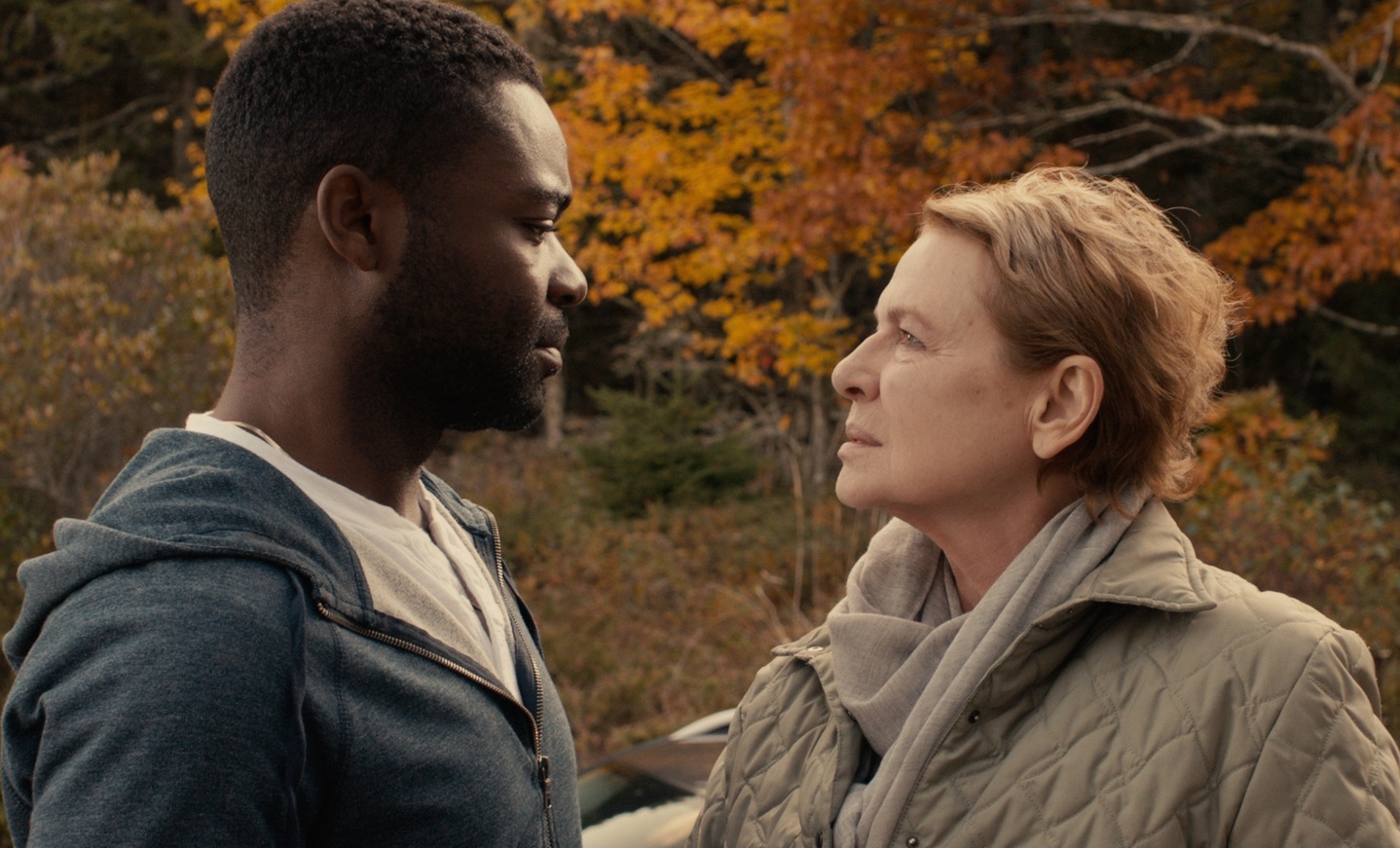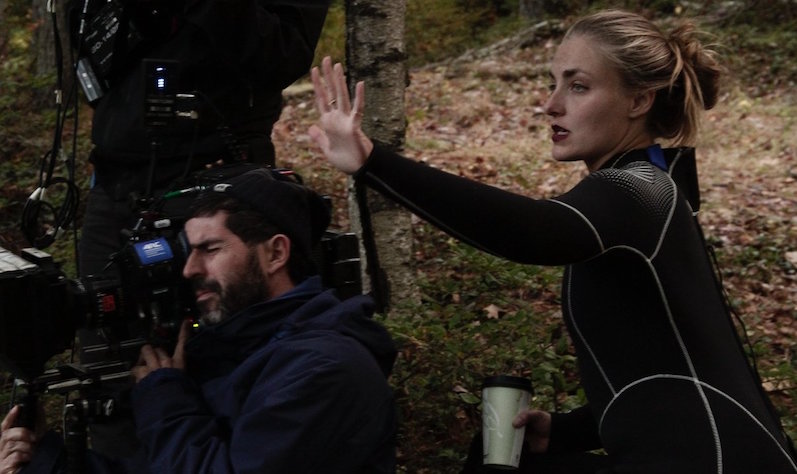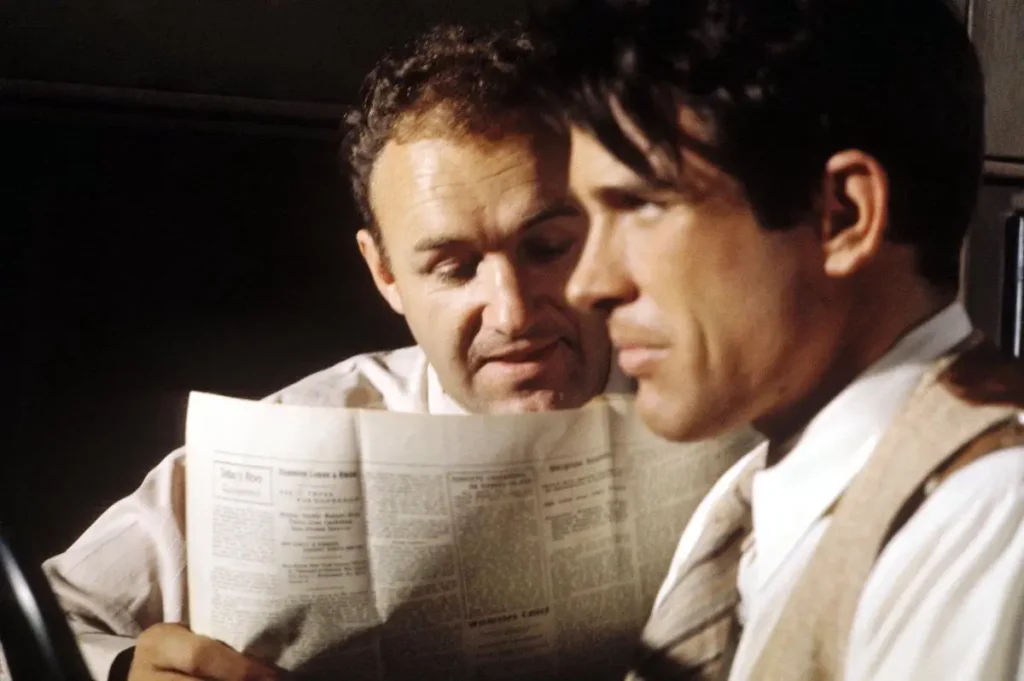Filmmaker MARIS CURRAN is coming off a very busy week. After her film FIVE NIGHTS IN MAINE wrapped up its nearly year-long festival tour at the Traverse City Film Fest, Curran bounced from Michigan to the New York premiere, then to the Los Angeles premiere, all in preparation for the film’s August 5 release (courtesy of distributor FilmRise). The character drama focuses on grieving widower Sherwin (David Oyelowo) as he reunites – and butts heads with – his estranged mother-in-law Lucinda (Dianne Wiest) at her home in rural Maine. Rosie Perez co-stars as Lucinda’s nurse, who helps Sherwin adjust to this strained and emotional visit.
As an artist who transitioned into filmmaking while in college (where she was also a Fulbright Fellow and received a Princess Grace Award for her thesis film), Maris Curran’s short films have screened at festivals and galleries around the world. Her feature debut, Five Nights in Maine was accepted to IFP’s No Borders International Coproduction Market, Film Independent’s Fast Track, Tribeca All Access, and the Cine Qua Non Writers Lab; and was the recipient of a Cinereach Grant, a San Francisco Film Society KRF Grant, and a Panavision New Filmmaker Grant.
Curran was nice enough to take some time from her busy schedule to talk to us about making Five Nights in Maine.
——
COLIN McCORMACK: I wanted to start by asking how David Oyelowo came on board as an actor and a producer, because I read somewhere that you approached him at a Sundance party and handed him your screenplay. Is that true?
MARIS CURRAN: It is true. We also had an introduction by Ava DuVernay, who directed the film he was at Sundance for, Middle of Nowhere. Ava and I had talked previously and she introduced us, [then] David and I talked about the project and I did indeed hand him the script, which he then went on and actually read that night. We met about a week later and actually sat down in LA and he came on both as an actor and a producer. I think when an actor comes on as a producer what they’re saying is, Not only do I want to act this character, but I really want to make sure that [the movie] gets made. Which was very important for the film actually coming to the screen.
CM: You spoke at length with Filmmaker Magazine about how the film was financed. And in that article you mentioned how filmmakers need to make sure to sign with financiers who have the same intentions for the final product as the filmmaker does. So I was just curious, were there any specific warning signs or red flags you encountered that made you realize certain investors weren’t on the same page as you in terms of what they wanted the final product to be?
MC: I think it’s less about that and it more became very clear that to get the film financed we were going to have to find champions. Champions of the film, of the script, and of me. And ultimately everybody who was signed on, all of the collaborators [were champions]. It was a challenging film to finance, as you can imagine. I am a first-time director, I’m a woman director, most of the cast is a cast of color, the second lead is a woman over 65, it deals with themes of grief and loss. Those are all reasons why it was challenging to finance. So I think more than anything talking about having partners who see eye-to-eye with you on the film you want to make in terms of the financiers really was about finding champions. Finding people who said, We see all of those things as things that are necessary in the world and we want to help you make it. And I found that in terms of equity investors but also in terms of the organizations that came on to support and campaign the film. We Kickstarted in development, and that was also a big part of it.
CM: How did you determine what was the right number to aim for in the Kickstarter campaign? Was that a debate back and forth? You don’t want to ask for too much and not hit the goal, but you want to be able to get as much as you can.
MC: Well it was quite a while ago when we did it [laughs]. What we ultimately hit was over $40,000 but this was many years ago when it was in development, before any of the actors were attached. And I think at that moment we were looking for an amount of money that could move the needle and really allow us to just start the film, get the word out, and begin to build a community around the film, and also make our campaign. And that’s what we did.
CM: You also received a number of grants. Do you have any advice for filmmakers who are applying to grants as part of their fundraising strategy?
MC: I think one secret among people who have gotten a number of these grants is they more likely than not have also been rejected – sometimes by the exact same grant organizations, sometimes multiple times. It’s really about making sure that you keep on trying. I think that’s the most important thing is saying, I’m going to keep on applying. You get so many no’s in this business that you really have to turn them into fuel for your fire and you have to become more determined and more clear in your voice and keep on coming back.
CM: And you also participated in labs, like IFP and Film Independent. Did you find those to be more beneficial as networking, community-building cultivation experiences, or were there hands-on lessons that you could apply directly to the production of the film?
MC: The types of labs I did – I did IFP, I did Fast Track which is part of Film Independent – those were really about meeting people who not only helped with this film, but are ideally part of my network now and for projects going forward. I also did an incredible screenwriting lab in Mexico called the Cine Qua Non Lab. I did that also very early in the film’s life and that was more [focused on] digging into the script and working on the structure and building the film in that way. And at the same time it was also networking. I became close with the other ten filmmakers and they are very much a part of my world [as] both professional and personal relationships that I’ll have for a long time.
CM: I’m not sure how long ago it was that you started writing the screenplay, but writing it with like you said a lead actress over the age of 65 was [seen as] a risk. But in the past year or so those adult-skewing films with older lead actresses like I’ll See You in My Dreams and Hello My Name is Doris and Grandma, those have been doing pretty good business at the box office. Do you keep tabs on the market and what kind of films are doing well, or what types of audiences are maybe being neglected? Is that important to you?
MC: I think that an awareness of what is happening in your field is important. At the same time if you’re saying, Oh I’m going to write this film because there’s a market for it, well the market’s going to change by the time the film hits. To me that’s not the key to being interesting. I hope that there are [more] films that are both female-helmed and have female characters at the center that [continue] to prove they can do well financially because I think there’s truth to that. For us, I was interested in making a film that is very much an adult film about feelings and dealing with very real issues that happen in life… And I think there are ways to show that, that there is interest in those genres.
CM: The film hinges so much on that relationship between Oleyowo’s and Dianne Wiest’s characters. Did they meet when filming started or did you have rehearsals with them?
MC: We didn’t really have much rehearsal. We shot the film in 19 days, so we didn’t really have time to. We obviously worked through the scenes before we shot them. But [David and Dianne] didn’t meet before and that was purposeful. Their relationship is strained in the film. I had David and Hani [Furstenberg], who played his wife, they met multiple times and began to work on that relationship. As did Dianne and Rosie, I spent an afternoon with the two of them in New York. But I think the first day that David and Dianne worked they had met the night before. The night before the first shoot day.
CM: Did you shoot in sequential order, so their first scenes filming together were when their relationship was colder, or was that not the case?
MC: We did not have the luxury of shooting [the film] in script order… We tried in terms of emotional reasons to shoot sequences in order, but we weren’t always able to do that.
CM: The racial element of Sherwin being African-American in a largely white rural area is really subtle. Was there ever a thought to bring the racial component more to the forefront of the script?
MC: No, because the theme of the film is about love and loss and relationships and family. And I think it’s important that we have films that are populated by actors of color, [and not] where the only theme that’s allowed to be addressed is race. We have to be able to have all of the other issues within humanity to be able to be expressed with that type of a cast. That doesn’t mean race isn’t an important element of the film. The way I think of it is as part of the fabric of the film, where the themes are love, loss, grief, empathy, and compassion. I know because of that, that was one of the reasons why we got this cast. That was something that made David want to do the film and made Rosie want to do the film. We had long discussions about that and David articulated it to me as, This is what life should look like. And it’s so rare that you actually get to see that in a film, particularly [because] Hollywood has a very narrow way in which they explore race, and it’s often didactic and it has to be the theme of the film. That’s not what we were interested in doing.
CM: Was it always written as Maine as the location where Lucinda lives?
MC: Yes.
CM: What made you decide on that as the right location to set the film?
MC: I grew up in Philly in a very urban, diverse, kinetic, and artistic neighborhood. But both of my parents are from New England and we would spend two weeks every summer in rural Maine with family. And even as a five-year-old I was struck by how wildly different these worlds were, and frankly how many Americas exist in our country. It’s something I’m very interested in exploring in all of my work. And the film is filled with contrasts. Maine is the poorest, whitest, most conservative state in the Northeast. It’s also ruggedly beautiful, a place we haven’t seen dramatically almost at all, particularly this section of Maine. And I think it’s a place that is ripe for [where] this relationship should unfold. On the one hand you can imagine the [Sherwin] character coming to where his wife comes from, and he’s able to have this sense of alone time and possible solace, and yet because of the environment and because of the context, it’s more alienating and exacerbates his grief.
CM: The alienation comes across, but it’s also so beautifully filmed. It made me miss seasons, being in LA. Trees! With leaves. And colors!
MC: And we shot in the Fall, which was wonderful.
CM: Yeah that seems like the perfect time to photograph that area.
MC: Yeah.

CM: I heard you hadn’t thought of filmmaking as a career until you took a film class at Smith College. I wanted to ask what were some of the movies you watched in that class that sort of lit the spark or made you think differently about film?
MC: It wasn’t through watching that I had that revelation, it was actually through the process of making. I grew up making things. My mom’s an artist, I grew up in a world where I made a lot of things, I wrote, I read, I watched movies. But I just didn’t understand that world as a career. I was 18 when I made my first film, and it really was this moment that just pulled everything that I loved together. Then I showed the film at the end of the semester to my peers and many of them cried, and it was like, Aha! You have the capacity to move people, and it really put the nail in the coffin for me. Then from there I was doing much more experimental films and videos, more for the gallery context. I went on to study at the School of the Art Institute of Chicago to get a master’s, which is not exactly on the trajectory of becoming a narrative filmmaker. And it was there that I realized it was indeed what I wanted to do.
CM: You had a pretty lengthy festival tour for Five Nights in Maine. Comparing that to your earlier works that screened at a lot of galleries, is there a noticeable difference in audience reaction or how you frame how you’re presenting a film when you’re there to introduce it or talk about?
MC: Yeah, but that was also quite a while ago. I’ve been working commercially and building up to making this film for quite a long time, so it’s not as if these are two things that I can easily compare and contrast. Traveling on the festival circuit, what’s been most amazing is being able to actually interact with an audience. The reason I made this film was to spark conversation. Grief can be such an alienating experience and something we’re taught needs to happen behind closed doors, and I think that people really want to have these conversations and in some ways seeing the film sort of grants them that permission. You’re invited to talk about it, to talk to each other, talk to me, talk through a Q&A format. It’s been overwhelming in the best sense, particularly traveling across this country and feeling that in places that are so geographically and demographically different and diverse. It’s been incredibly moving.
CM: And you’re working on your next feature now?
MC: I am, yeah. I wrote it and am in the beginning stages of packaging it.
CM: Has it been – I don’t know if “easier” is the word – but with a feature under your belt about to be released, was raising funds for the follow-up a slightly less difficult or torturous process?
MC: It’s bit too early to say, we’re not 100% financed. We definitely have some financing in, but I will be very happy when we get there! [Laughs]
__
Thanks again to Maris Curran for taking the time to speak with us about FIVE NIGHTS IN MAINE. Follow the film on Twitter or Facebook.
If you’re an independent filmmaker or know of an independent film-related topic we should write about, email blogadmin@sagindie.org for consideration.



